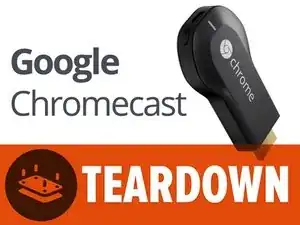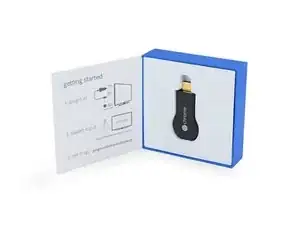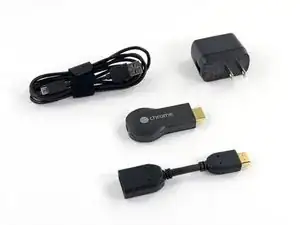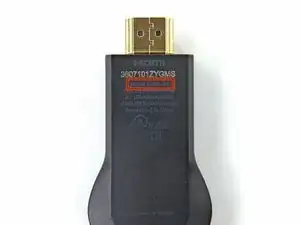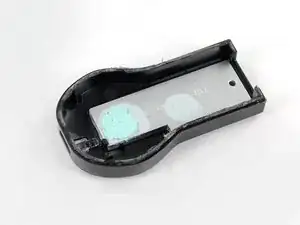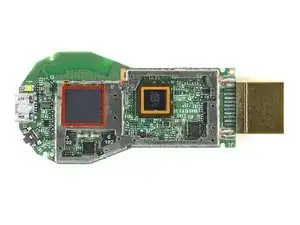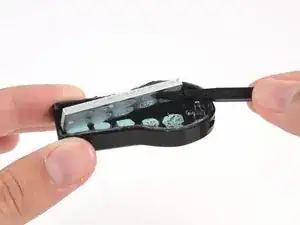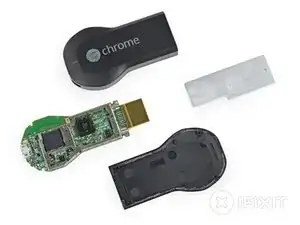Introduction
Ding-dong, the dongle's here! Google knows that cat videos are more entertaining when viewed on a 72-inch HD display, so they packed Chrome into a compact dongle, threw an HDMI output on it, and provided the world with the cat videos we deserve! Join us as we tear down the Chromecast to find out how Google squeezed so many cats into one small package.
Want to stay in the loop with our most recent goings-on? Follow us on any or all of our social media outlets! Fixin' for some filters? Instagram it is. More of a text person? Twitter! Enjoy compound words? Say hello to Facebook.
Tools
-
-
Upon eagerly ripping open the Chromecast's box, we are greeted with more than just a dongle.
-
The dongle's specs and features:
-
1080p HDMI output
-
2.4 GHz WiFi 802.11 b/g/n
-
1080P maximum output video resolution
-
USB-powered
-
Compatible with a variety of devices, including both iOS and Android devices
-
-
-
Model Number: H2G2-42.
-
We see what you did there, Google. Your clever nerd humor will not be lost on us!
-
Call us speculative, but it appears Google thinks this device is the answer to life, the universe, and everything.
-
-
-
The first thing out is, well, everything. Pulling the motherboard assembly out of the Chromecast leaves us with an empty shell.
-
Almost empty, that is, except for some excessive thermal leftovers and a big hunk of aluminum heat sink.
-
-
-
The central nervous system:
-
AzureWave AW-NH387 802.11 b/g/n WLAN, Bluetooth and FM Combo Module
-
Marvell DE3005-A1 System on Chip
-
Micron MT29F16G08MAA 16 Gb (2 GB) NAND Flash Memory
-
Micron D9PXV 512 MB DDR3L SDRAM
-
-
-
With the motherboard out, only one component remains: a (relatively) ginormous heatsink. Made of solid aluminum and spanning the entire length of the device, it rests—lifeless hardware in a tiny coffin.
-
We can't say we're surprised, though, as the product information states "Chromecast may get hot to the touch; this is normal."
-
This is somewhat disconcerting, sort of like "melt in your hand, not in your mouth," or "side effects may include death."
-
-
-
We’ve decided not to assign a repairability score to the Chromecast.
-
There’s just nothing in it to repair. The Chromecast is essentially a luxury item with a limited use.
-
27 comments
HDMI 1.4 can power the device without USB power.
Thanks, that's great to know..
This is incorrect, people have tested this and it doesn't work.
Dongle, dongle, dongle... yes, it is a fun word to type.
Any warning which includes the phrase "this is normal", clearly indicates something which any normal person would realize is not normal.
Next teardown a Galaxy Minstrel .... or was that just a British thing? They don't melt in your hand (according to the advert anyhow) www.youtube.com/watch?v=R8ggWmC_Cpg
Bees -
Very very interesting design. Lots of somewhat surprising things! In particular, TSSOP flash was a little unexpected... I don't suppose you guys still have one around to try ripping the flash off of to see if there are BGA landings under there?
Other aggressively cost-reduced NAND consumers (i.e., USB thumb drives and SD cards) often have landings for both BGA and TSSOP flashes so that they can quickly change to whatever the cheapest source of NAND flash is that day without having to spin a new SKU of their board... would be interesting to know if Google did the same here.
